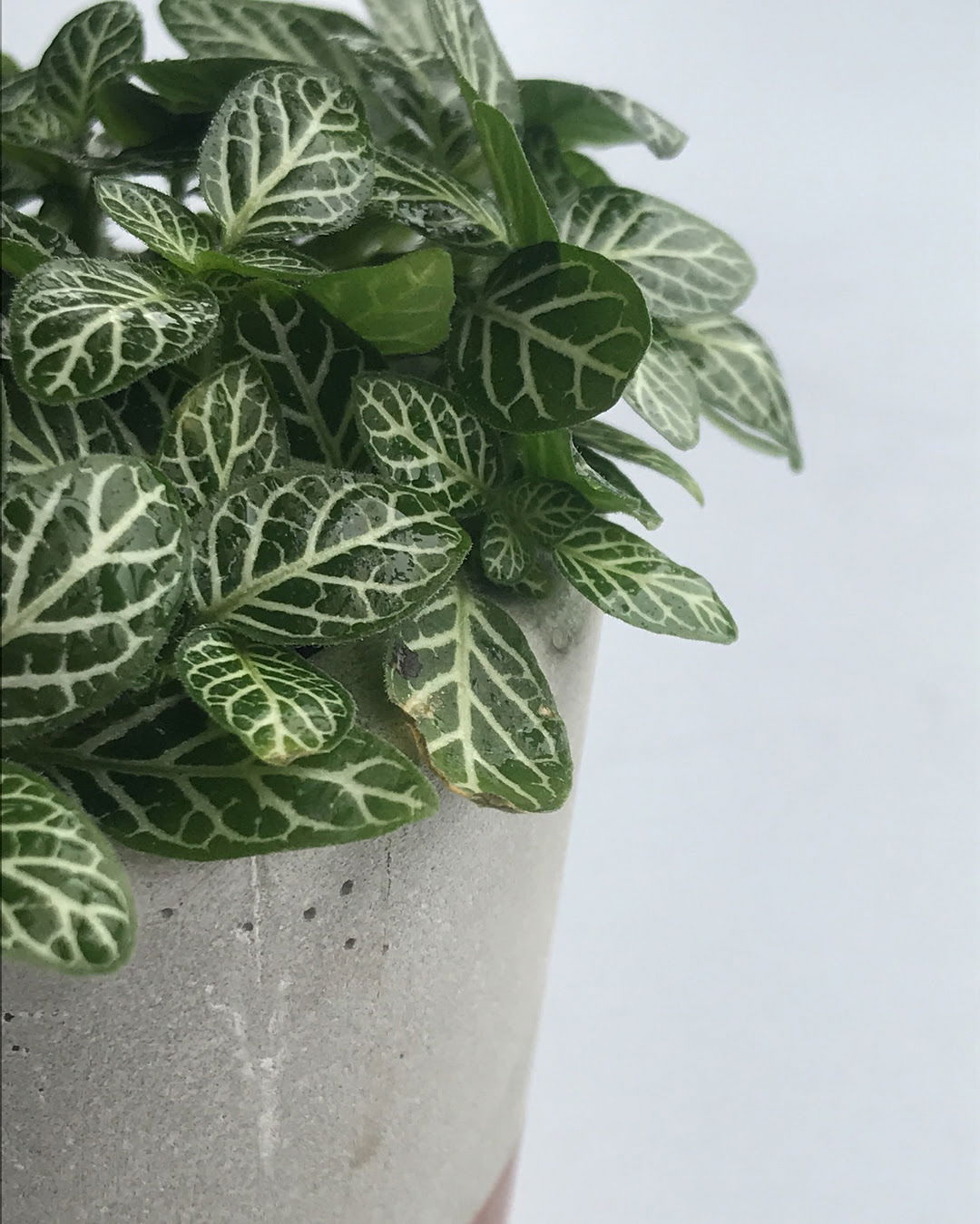
Fittonia albivenis 'Argyroneura'
Contents
- Top Tips
- Location, Water, Humidity & Fertilisation
- Common Issues
- Origins, Temperature, Propagation, Repotting & Toxicity
Need the answer to a specific plant query? Book a 1-to-1 video call with THE HOUSEPLANT DOCTOR™, the website's friendly author, to overcome and address your niggling problem! Available on iMessage, WhatsApp, Facebook Messenger & more.
Top Tips & Info
- Care Difficulty - Easy (when sufficiently hydrated)
- No direct sunlight; a bright, indirect setting is more than enough to occupy Fittonia as exposure to the intense rays will burn its foliage.
- Water once the top inch dries out, avoiding persistent droughts at all costs.
- Provide a humid location, especially while the heaters are operating. Introduce a pebble tray to maintain a stable level of atmospheric moisture, along with lengthening the soil-drying process.
- Fertilise using a 'Houseplant' labelled feed every three waters in the spring and summer, reducing this to fourth drink in the colder months.
- If the foliage crisps up, scroll down to 'Common Issues' for more information and advice.
- Repot every three years using a slightly water-retentive soil like 'Houseplant' compost.
- 'Tot' specimens in a 5cm pot (available at Blue Diamond stores in the U.K.) are perfect for tropical-themed terrariums or displays due to the slow growth habits!
- Keep an eye out for Mealybugs that'll locate themselves in the foliage's cubbyholes.
Location & Light - 🔸🔸
Bright, indirect light is best for Fittonia, as too little light may result in lower yellowing leaves. The ideal locations are on a north-facing windowsill, or a table/bookshelf within 3m (9ft) of a window. Specimens grown in darker locations will need to be watered far less than those in brighter climates due to the increased chance of botrytis when excess moisture remains on the leaves. Avoid direct sunlight at all times.
Water - 🔸🔸🔸🔸
Only allow the top inch to dry out in between waters, reducing this slightly further in the autumn and winter. Although Fittonia will dramatically wilt if they endure short periods of droughts, it's usually harmless and should bounce back after several hours if the foliage is functioning still. Under-watering symptoms include a bare stem with little or no remaining leaves & stunted growth. These are commonly down to either forgetfulness or intense sunlight; scroll down to 'Common Issues' for more information. Over-watering symptoms include yellowing lower leaves and a rotten stem. Make sure your plant is situated in a brighter environment with slightly fewer irrigations if this is the case. Never tinker with the roots unless wholly necessary during a repot as it could cause transplant shock and eventual death; it's always best to leave a Fittonia at bay, instead of addressing the situation via its soil.
Humidity - 🔸🔸🔸
High humidity will slow the rate of drying soil and dehydration considerably, so introduce a pebble tray to improve its surrounding environment. Mist the foliage from time to time to hydrate its leaves and wash-away the thin layer of dust. Those situated in dark locations mustn't be over-saturated as excess moisture, and poor air circulation could develop into botrytis or leaf-spot disease.
Fertilisation - 🔸🔸
Feed every three waters during the growing period and every four in the autumn and winter, using a 'Houseplant' labelled fertiliser. Never apply a 'Ready to Use’ product into the soil without a pre-water first, as it may burn the roots and lead to yellowed leaves.
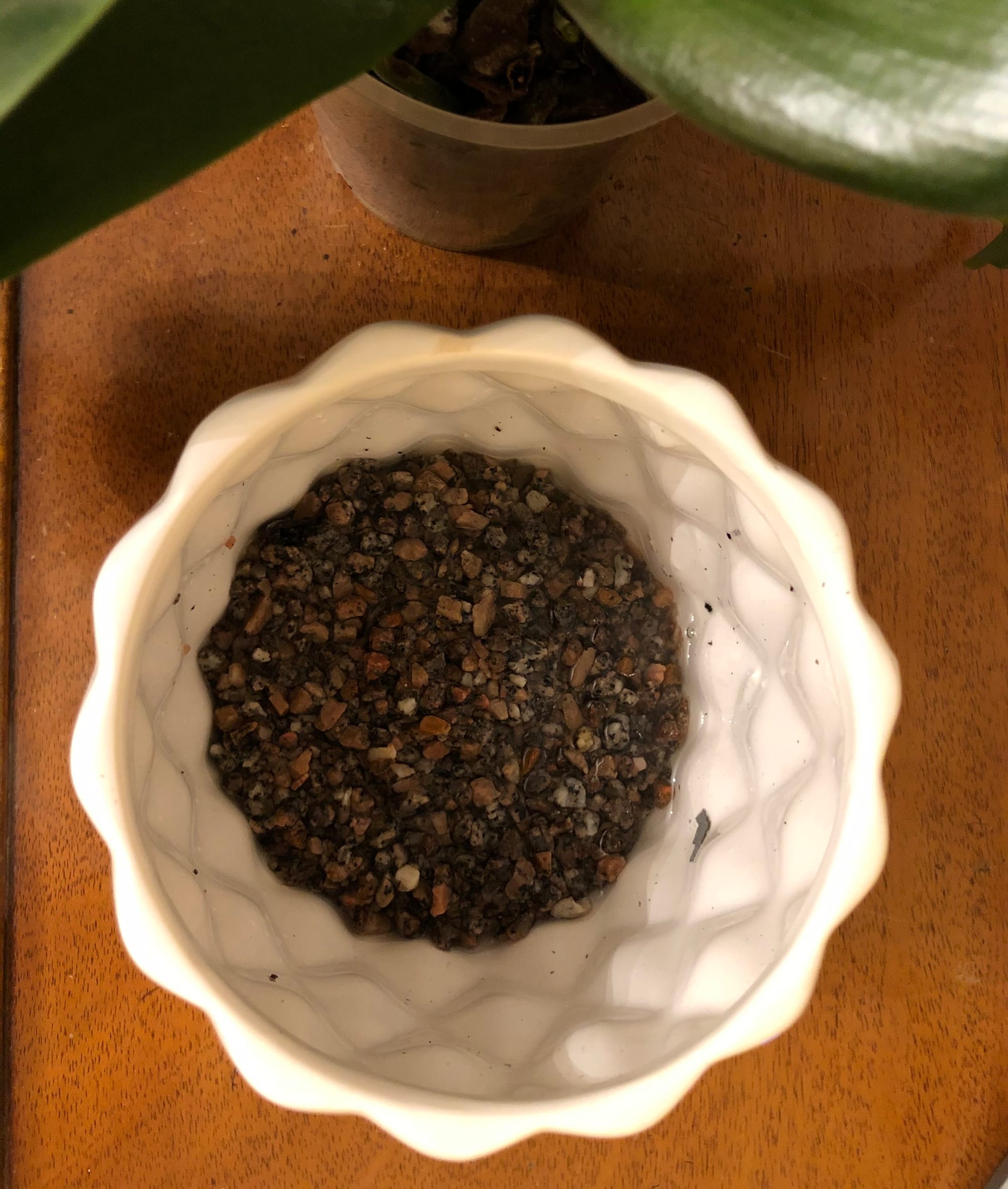 If your Fittonia constantly wilts with dehydration, why not fill the decorative pot's bottom sixth with small grit? This will promote more reliable soil moisture that'll help encourage better growth & all-round health as the excess moisture will drain from the plant's plastic pot, thus creating a humid environment for root interaction.
If your Fittonia constantly wilts with dehydration, why not fill the decorative pot's bottom sixth with small grit? This will promote more reliable soil moisture that'll help encourage better growth & all-round health as the excess moisture will drain from the plant's plastic pot, thus creating a humid environment for root interaction.
Common Issues with Fittonia
When a Fittonia is severely dehydrated, most of its leaves will crisp-up and fall off - leaving you with a naked plant. Although it may spell the end of juvenile plantlets, there may still be light at the end of the tunnel for more established specimens. If its stem is still plump without any signs of retraction, prune-away the seriously affected areas and contain the plant (with its pot) in a transparent bag or glass container (image below) that has small holes. Keep the soil continually moist, providing a good level of indirect light and temperatures above 15°C (59°F). Remove from the bag or transparent container after two months of solid foliar growth.
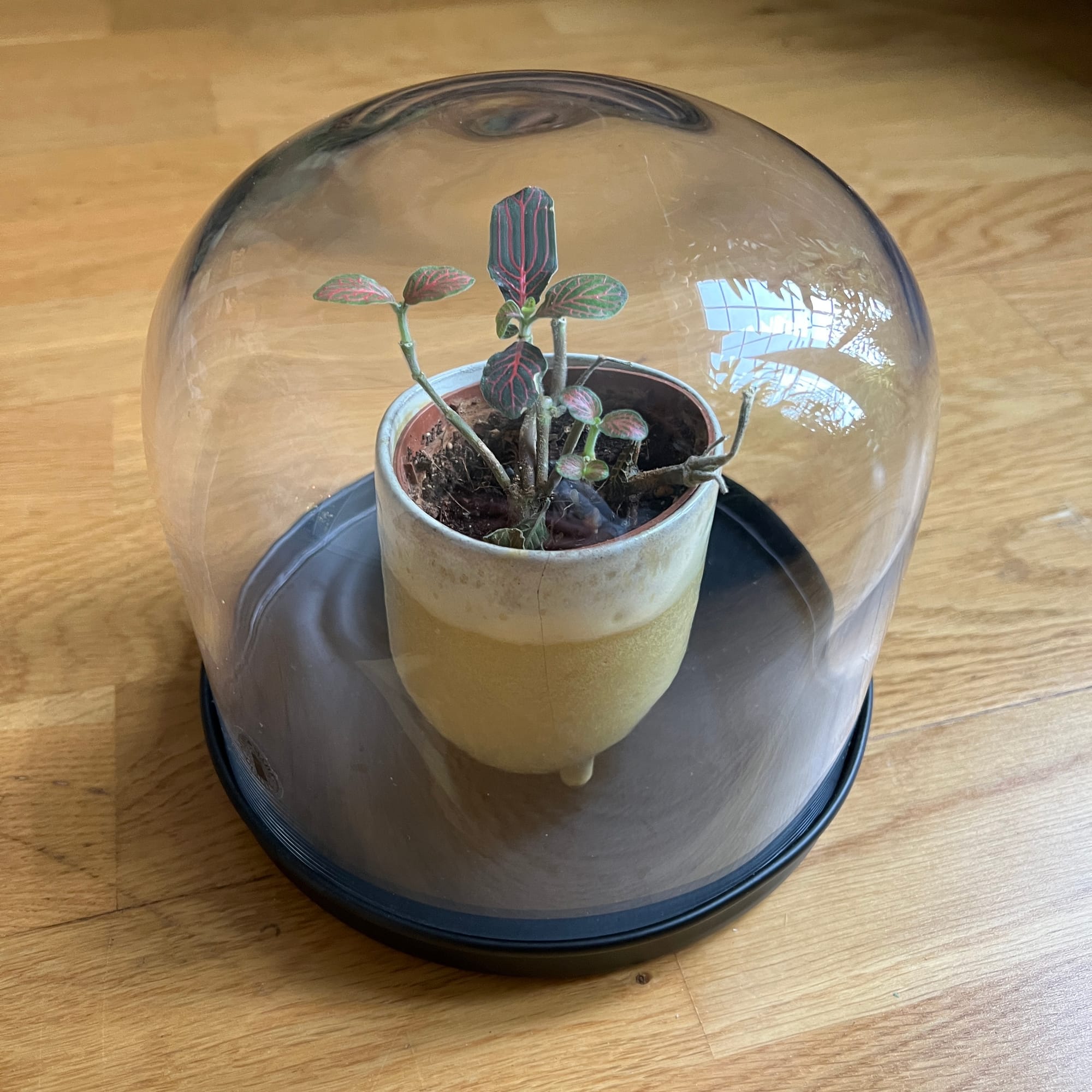 If your Fittonia (Nerve Plant) has been dehydrated and lost most out of its leaves, place it in a plastic bag or transparent dome to invigorate new foliage. Keep the soil moist at all times and provide a bright, indirect window!
If your Fittonia (Nerve Plant) has been dehydrated and lost most out of its leaves, place it in a plastic bag or transparent dome to invigorate new foliage. Keep the soil moist at all times and provide a bright, indirect window!
Mould developing on the soil means two things - too little light and over-watering. Despite the harmlessness of the mould, it'll prove unsightly to most gardeners and is therefore removed once known. To remove, replace the top two inches of the soil for a fresh batch of 'Houseplant' compost. Either increase the amount of light received (no direct sunlight for the first few weeks to prevent environmental shock) or decrease the frequency of waters slightly. If the mould is accompanied by yellowing lower leaves, you may also have a case of root rot.
An under-humid room will not benefit Fittonia in the slightest. Mist the foliage weekly and introduce a humidity tray to keep life manageable. Avoid situating it within four metres of an operating heater, as the dry air will spread up the process of browning leaf-tips and soil dryness.
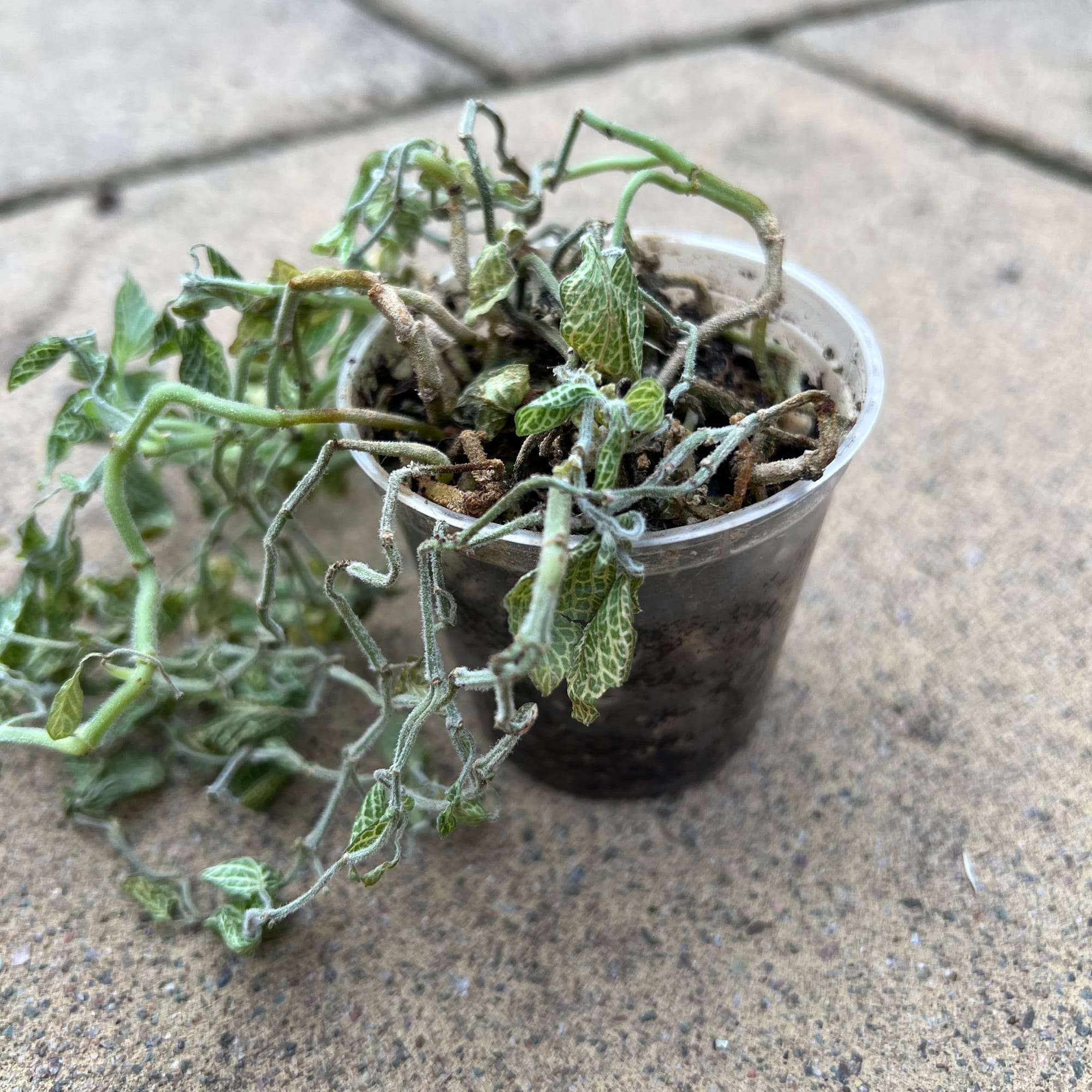
Rapidly yellowing older leaves and shriving stems are typical signs of over-watering, where soil conditions are far too soggy for its liking. There are two ways in which you can help alleviate the situation; decrease irrigations, move to a brighter location with bright indirect light, or inspect the root ball for root rot. For the latter (like the photoed Fittonia above), check for brown, mushy root systems, commonly found at the base of the pot. If the roots are yellow and plump, you're good to go; however, if they're black and weak, cut off the affected areas using clean utensils and replace some of the soggy soil with a fresh batch of 'Houseplant' compost; introduce some grit for extra drainage and promotion of a stronger root system.
Curled leaves and brown leaf-edges are the result of too little water and over-exposure to the sun. Fittonia are best located in bright, indirect settings, and those that haven't acclimatised to the harsh rays will show signs of sun-scorch and environmental shock. A splash of winter sunlight is acceptable as long as the soil moisture is regularly observed, with complete avoidance once summer comes along.
Pests could arise at any time, with infestations starting from the original nursery or via contamination in your home. Spider Mites and Mealybugs tend to be the usual inhabitants, with the first being minute and almost transparent, roaming the leaves in search of chlorophyll and a site to hide its eggs. The latter, however, will stand out much more, with white cottony webs developing across the foliage and stems. Thoroughly check the plant's cubbyholes before giving it the all-clear, or click on the appropriate links to learn more about eradicating these issues.
Origins
Fittonia is a genus of perennial creepers that mainly originates from tropical regions of South America, including Peru, Bolivia and Brazil. The genus was named in honour of an Irish writer and keen botanist, Sarah Fitton who conducted most of her work during the 1860s. The most popular species, F. albivenis, was first described as Adelaster albivenis in 1861, before being reclassified several times (including the synonym, F. verschaffeltii) into its current name by Richard Brummitt in 1979.
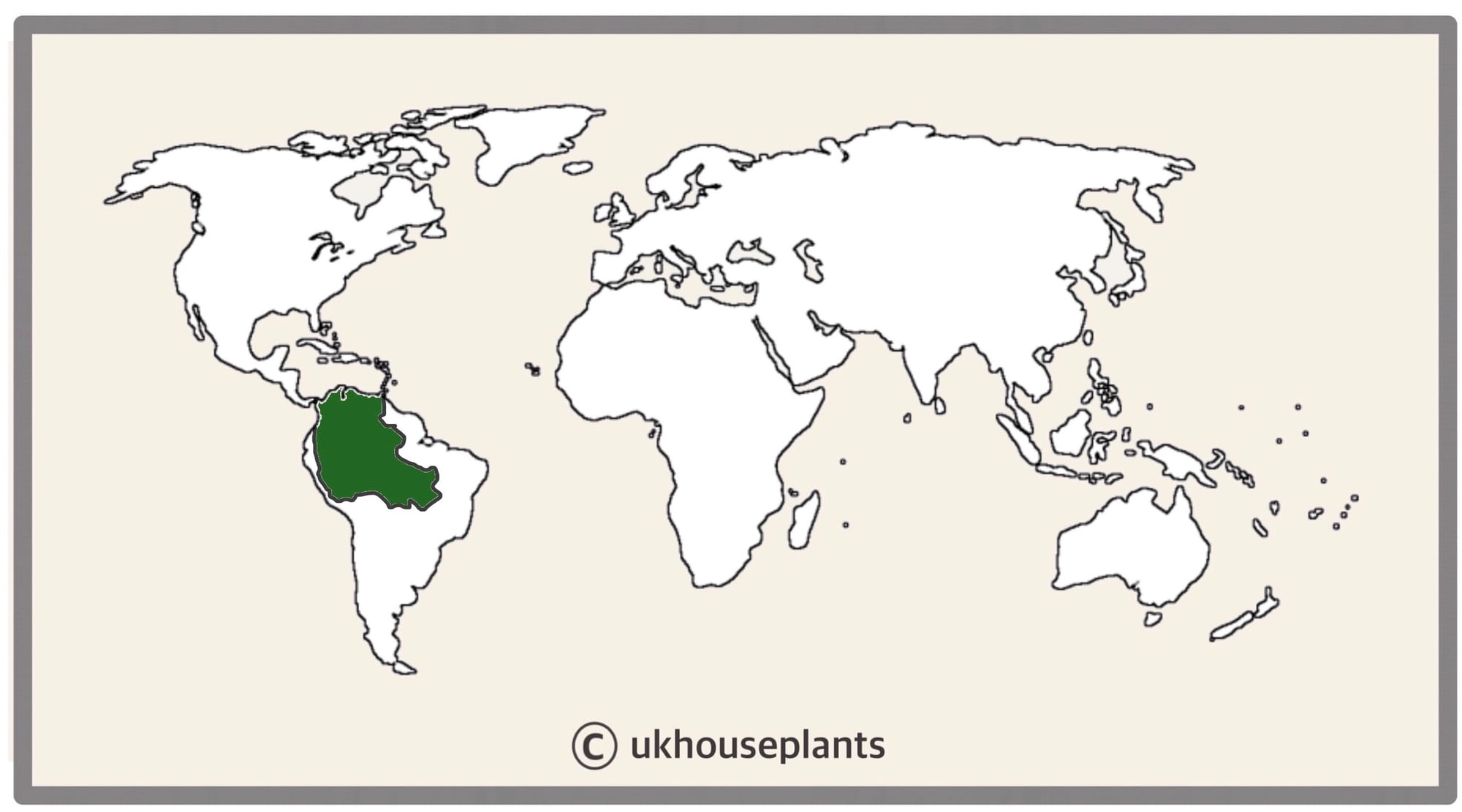 The Distribution of Fittonia.
The Distribution of Fittonia.
Temperature
15° - 24°C (59° - 75°F)
H1a (Hardiness Zone 13) - Must be grown indoors or under glass all year round. Never allow temperatures to dip below 15℃ or permanent damage may occur in the likes of flower loss, stunted growth and yellowed leaves.
Spread
Up to 0.3m in height and 0.6m in width once they reach maturity. The ultimate height will take between 3 - 5 years to achieve. The F. gigantea can reach heights of 60cm once maturity is reached.
Pruning & Maintenance
Remove yellowed or dying leaves and plant debris to encourage better growing conditions. Pruning can be done with either clean scissors or by pinching the leading shoots to keep its overall height in control. The prunings can also be used as stem cuttings.
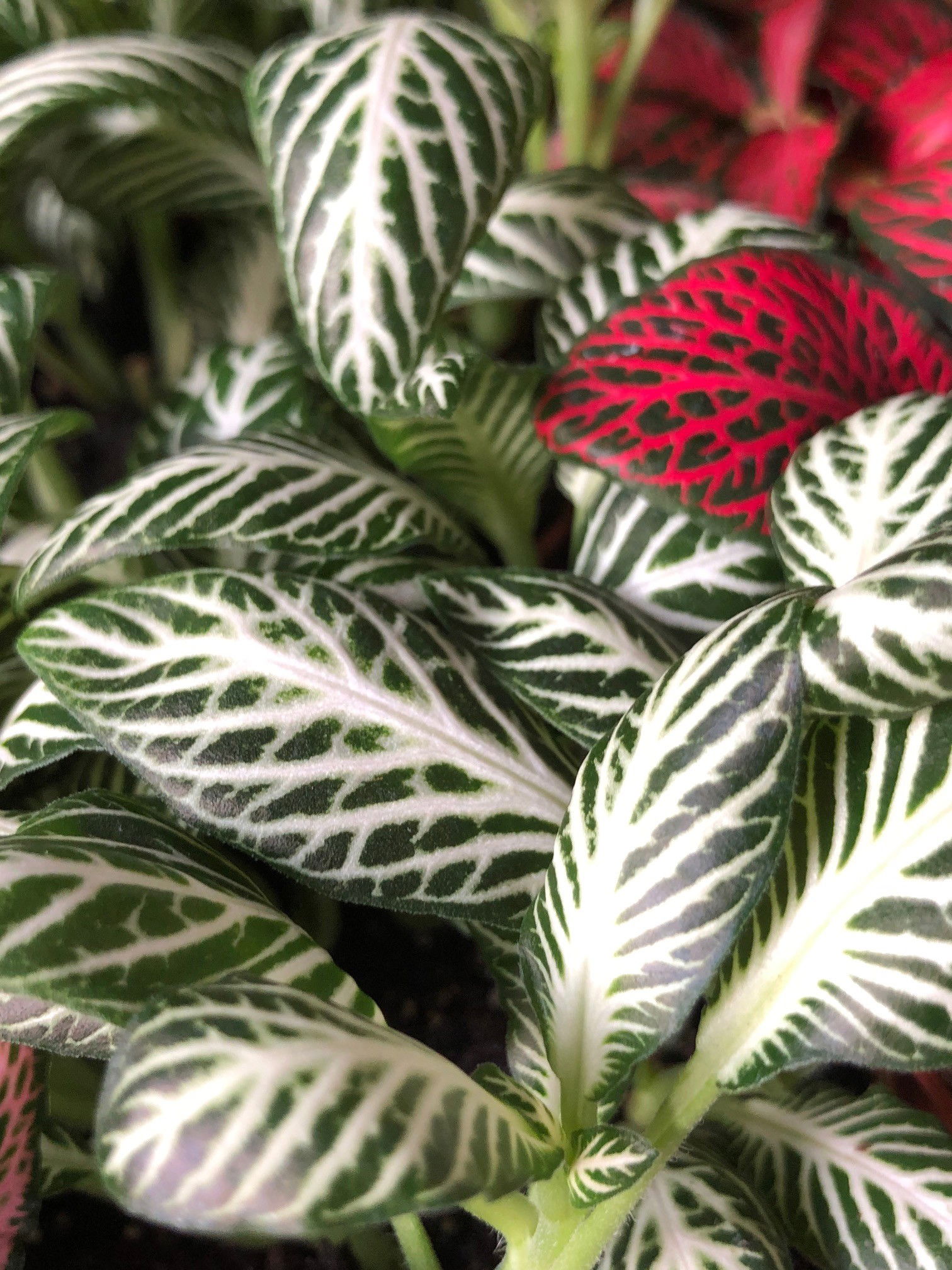 Fittonia albivenis
Fittonia albivenis
Propagation
Via Seed, Division or Stem Cuttings.
Division (Easy) - Split the root ball into several sections during the start of spring. Dividing too-small segments of the rootball could lead to transplant shock or unsuccessful propagation. Sections that are at least 5cm (2 inches) in diameter serve the best chance of propagation due to the stored energy in the roots and stems. Place the sections into 'Houseplant' compost and water regularly, avoiding prolonged sunlight or persistent droughts.
Stem Cuttings (Moderate) - This propagation method can be taken from spring to late summer, using between three to five leaves, with a stem length of 5cm (2 inches). Cut directly below a node using a clean knife to reduce bacteria count and remove the older 50% of the leaves. Dip the wound in some rooting hormone before setting it into a well-draining potting mix, for example a 'Houseplant' labelled compost. Blackleg can occur when the bottom wound becomes infected, typically caused by water-logging or a too-damaged wound. Maintain bright light and evenly moist soil with the avoidance of direct sunlight or cold draughts. Wrap the pot (& foliage) in a transparent bag or within a miniature greenhouse, and provide bottom hear of temperatures above 18°C (54°F). Remove the bag after a month and maintain the same cultivation. Follow the care advice mentioned in the article's top half. This method will take up to three months, so patience and the correct environment are paramount for success!
Flowers
Most likely in springtime, Fittonia will produce small white or pink flowers on the tips of each stem. Unfortunately, the blooms are quite insignificant and therefore can be pruned off to favour more foliar growth on the plant.
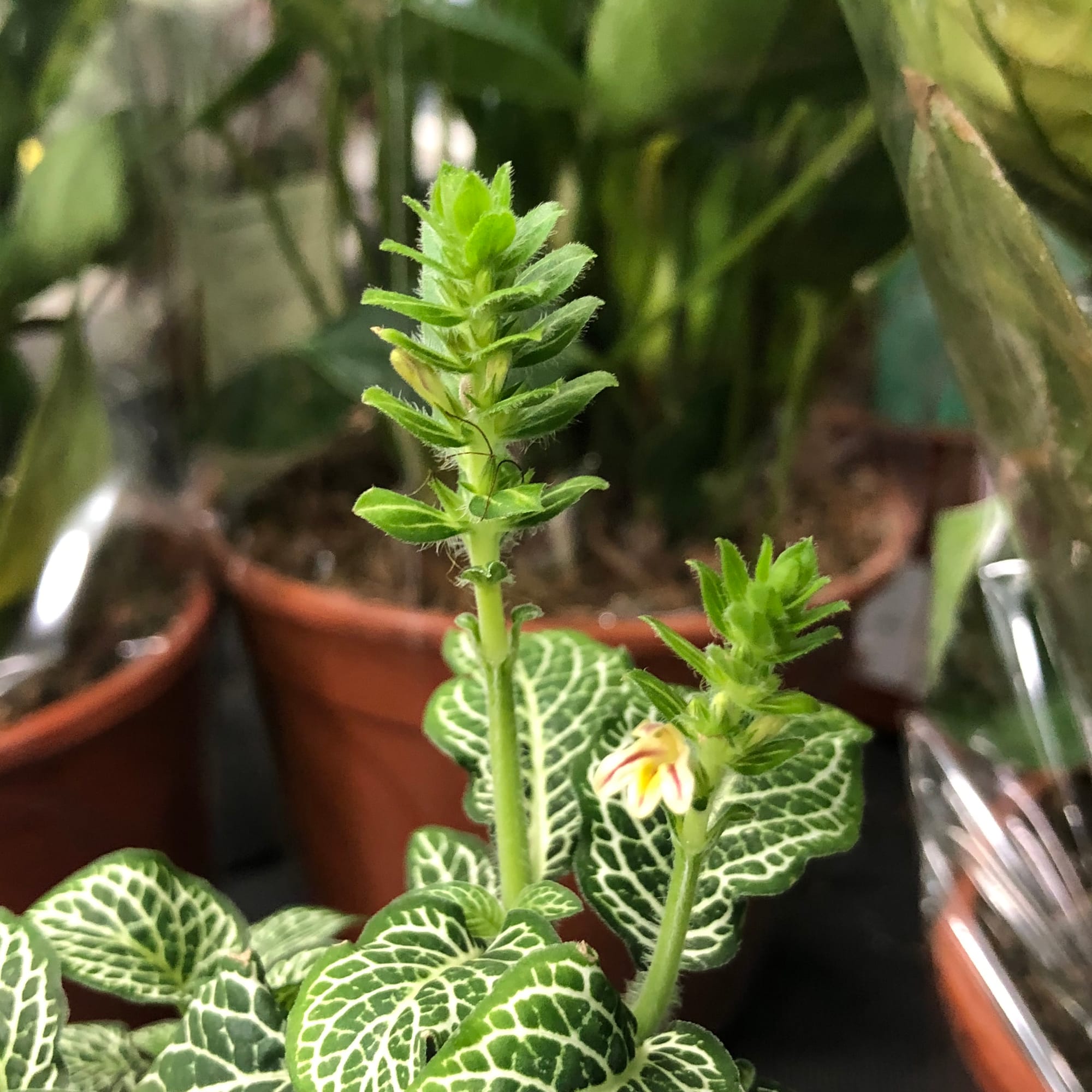 Similar to the popular houseplant, Hypoestes (Polka Dot Plant), Fittonia sport an upright cluster of foliage that can emerge at almost any point of the year.
Similar to the popular houseplant, Hypoestes (Polka Dot Plant), Fittonia sport an upright cluster of foliage that can emerge at almost any point of the year.
Repotting
Repot every three years in spring using a 'Houseplant' labelled compost and the next sized pot with adequate drainage. As Fittonia are ground creepers, they tend to grow quicker in a wide, shallow pot; visit your local garden centre and search for 'Terracotta Bulb Bowls' which should be on sale all year round. Hydrate the plant 24hrs before tinkering with the roots to prevent the risk of transplant shock. For those that are situated in a darker location, add a thin layer of small grit in the pot's base to improve drainage and downplay over-watering. Click here for a detailed step-by-step guide on transplantation, or via this link to learn about repotting with root rot.
Book a 1-to-1 video call with Joe Bagley if you'd like a personal guide to repotting your houseplant. This will include recommending the right branded-compost and pot size, followed by a live video call whilst you transplant the specimen for step-by-step guidance and answer any further questions!
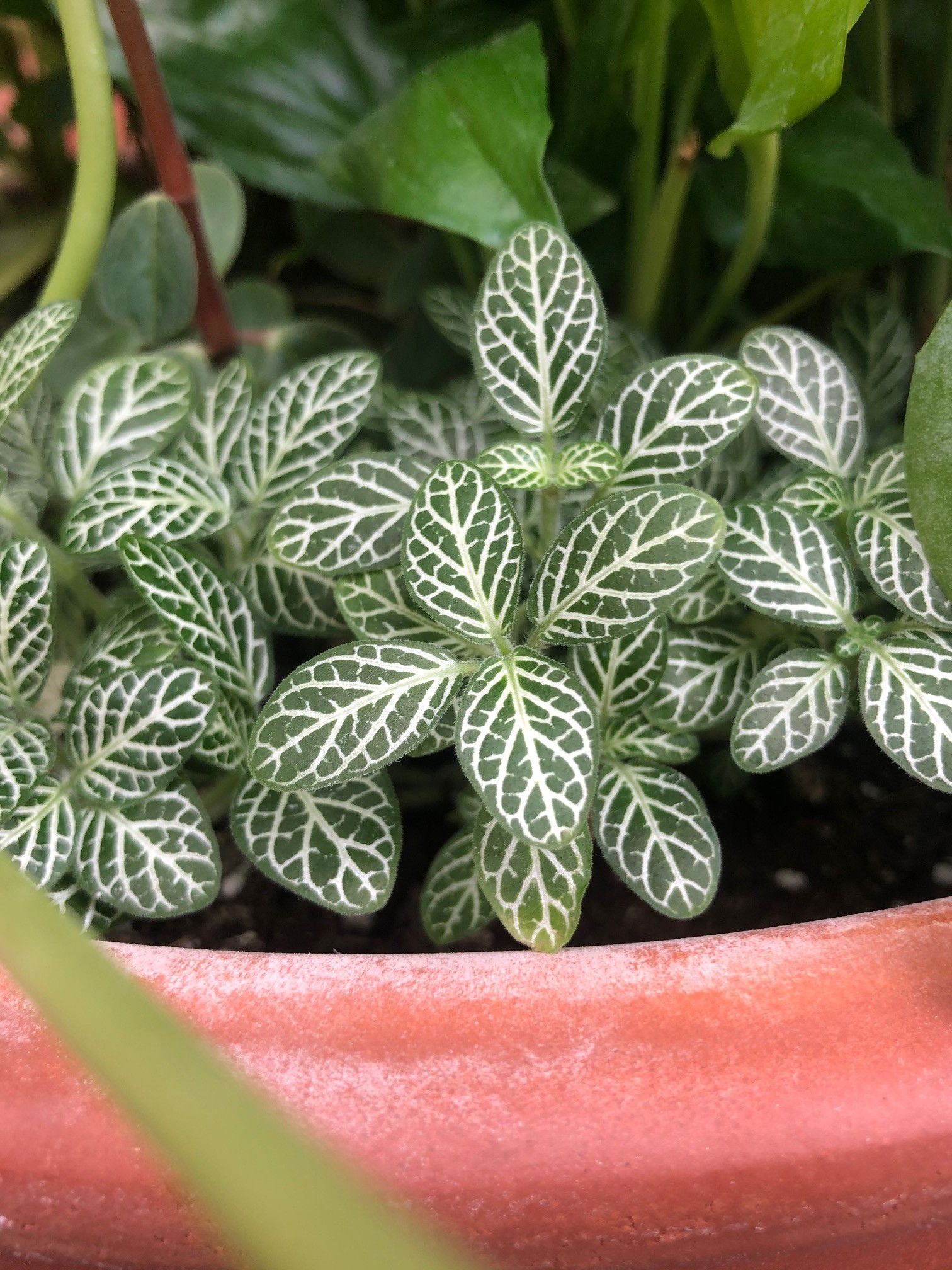 Fittonia serve as a great 'ground cover' plant in Terrariums due to its fast-growing nature and beautiful foliage!
Fittonia serve as a great 'ground cover' plant in Terrariums due to its fast-growing nature and beautiful foliage!
Pests & Diseases
Keep an eye out for mealybugs, aphids, spider mites, scale, thrips, blackfly, vine weevils & root mealybugs that'll located themselves in the plant's cubbyholes, with the exception of the latter two in soil. Typical diseases associated with Fittonia are root rot, leaf-spot diseases, rust, southern blight and powdery mildew - click here to learn more about these issues.
Toxicity
Not known to be poisonous by consumption of pets and humans. If high quantities are eaten, it may result in vomiting, nausea and a loss of appetite.
Retail Locations
Blue Diamond, Dobbies, IKEA, Online Stores.
Book a 1-to-1 Call with THE HOUSEPLANT DOCTOR™
If you need further advice with your houseplants, book an advice call with ukhouseplants' friendly and expert writer today! This can be done via a video or audio call on most apps, including Facebook, FaceTime & Skype. A ten-minute call costs £5.99 (US$7), or £15.99 for thirty minutes. You can ask multiple questions, including queries on plants, pests, terrariums, repotting advice and anything in between. Please consider supporting this service to keep ukhouseplants thriving!